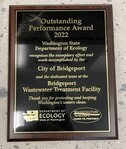




BRIDGEPORT – When Superintendent of Public Works Stuart Dezellem told the October meeting of the city council that a Department of Ecology (DOE) award presented to the city’s wastewater treatment plant (WWTP) was “the most significant” of any previous it has received, the comment, in hindsight, was an understatement.
The WWTP is just emerging from a three-year nightmare of borrowed equipment, fix-on-the-fly challenges, round-the-clock monitoring, and cobbled together contraptions to not only maintain the city’s water sanitation but to do it with the highest quality control standards. Plant manager Martin Landin and his co-worker, Howie Dikson earned well-deserved praise from their boss for making that happen.
“We still did not have a lab,” said Dezellem. “Martin was working out of a trailer; we were pumping sludge with a hand-made pump…and no violations, no permit violations at all during the whole calendar year.”
Bridgeport lost its WWTP lab building in the 2020 Pearl Hill wildfire that destroyed nearly two dozen homes in the city. Combined with delivery delays caused by the COVID pandemic, it has taken until 2024 to rebuild and re-equip the facility to the point where it is now applying for re-accreditation from the DOE.
Landin said he was in Idaho visiting relatives during Labor Day weekend when what would become the Pearl Hill wildfire erupted near Omak 40 miles north in Okanogan County. As he attempted to make the return drive home, he encountered highway closures from other wildfires in Davenport and again at Moses Lake and finally between Brewster and Bridgeport. By the time he arrived by alternate routes the lab building was gone.
Both Dezellem and Dikson were scrambling to save their homes so Landin made a quick assessment of the plant damage.
While the lab and its computers and other equipment was gone, Landin determined that other parts had survived.
“We were lucky,” said Landin pointing to a second building on the west end of the grounds. “The brains of the plant in the electrical building did not burn.”
More good news. Everything was still running though Landin had no computers left to monitor the data and had to verify everything manually.
“We have a good generator, and it took over to keep everything running,” Landin said.
The first order of business was securing a source of power and a temporary structure to house a makeshift lab.
A representative from Evergreen Rural Water in Shelton stepped in to help with equipment, strategy, and paperwork. Electrical and computer specialists helped establish basic connections.
The City of Brewster came through with a spare generator and a trailer was hauled in to serve as a temporary lab facility.
“The worst part was the pumps in the basement that handled the wastage,” said Landin. “They burned up, so we were trying to figure out how to do that.”
What they came up with was a temporary pump placed in a holding tank with a length of fire hose to a second tank to do the job. The hose had to be rolled out and connected in the morning and disconnected and rolled up at the end of the day.
“That was an everyday deal for about two-and-a-half years,” said Landin.
Then there were the monthly reporting requirements and weekly water samples that Landin had to complete without the aid of data he relied on to do so. The DOE was understanding but the reports were critical for monitoring standards let alone achieving outstanding performance levels.
A few details remain to get the lab back to pre-fire status but with the worst elements now in the rearview mirror, Landin and crew can reflect with pride that while they did not dodge disaster, they absorbed the hit.
Mike Maltais: 360-333-8483, michael@ward.media
Comments
No comments on this item Please log in to comment by clicking here